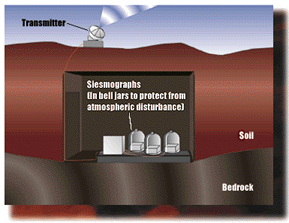
Within the first microsecond of a subterranean blast, a fiery bubble of vaporized rock forms at pressures of several million atmospheres. The expanding gas forces open a cavity, while the shock wave pulverizes rock as it expands into the surrounding earth, then travel for hundreds of miles through the planet. Seismographic stations feel the waves as they pass beneath.
Infrasound, hydroacoustic, and seismic sensors perform the same function in different environment-they listen for shock waves then print out a corresponding series of crests and troughs. But radiation detectors will provide a completely different readout. | ||
 |
